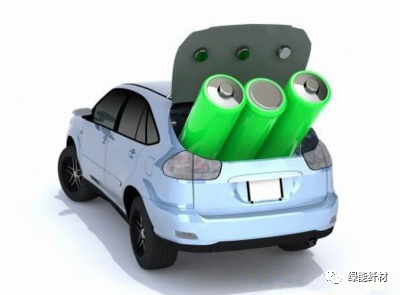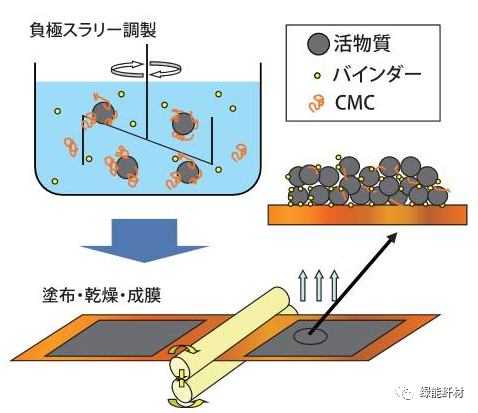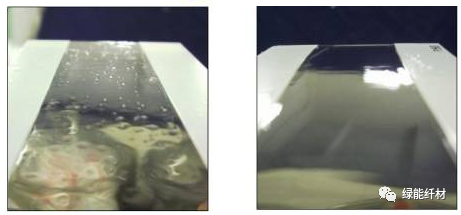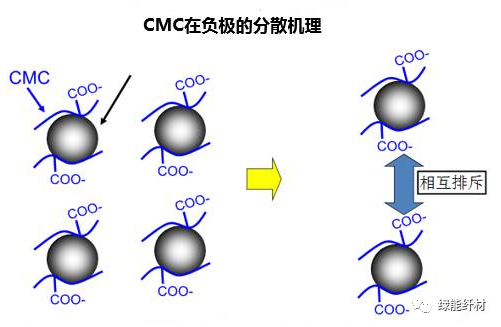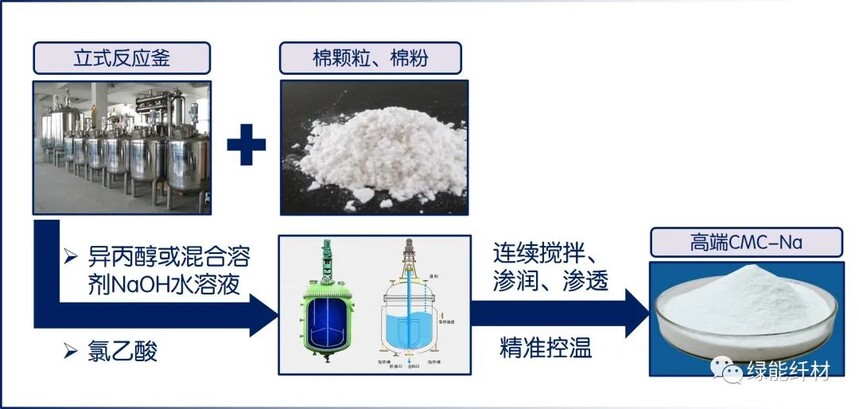New energy material CMC
Knowledge popularization
Carry forward the past and forge ahead
With the transformation of the global energy structure, new energy materials are playing an increasingly important role in today's society. New energy materials refer to the general term for materials used for energy conversion and storage, including materials in the fields of solar energy, wind energy, water energy, geothermal energy and so on. Among these new energy materials, CMC is a new energy material that has attracted much attention and has broad application prospects.
Sodium carboxymethyl cellulose CMC-NA, CMC for short. It's a carboxymethyl ether of cellulose. It's a salt. It is also one of the important water-soluble polymers, an anionic linear polymer. Or natural cellulose after chemical modification, glucose polymerization degree of 100~2000 cellulose derivatives. White fibrous or granular powder.
The preceding figure shows the CMC structure
CMC has the functions of thickening, bonding, water retention, emulsification and suspension in aqueous solution. It is widely used, commonly known as "industrial MSG". In the field of new energy has a wide range of application prospects, as follows:
1, in the paper industry as an additive can improve the longitudinal strength and smoothness of paper, in the coating processing as a viscosity regulator, improve the printing adaptability of paper.
2, used in the petroleum industry as a suspension stabilizer of drilling mud, used in oil, natural gas drilling, drilling and other projects can make the wall form thin and firm, low permeability filter cake. The reduced water loss allows the rig to achieve a low initial shear force, making it easier for the mud to release the trapped gas and discard the debris in the mud pit. CMC is used as drilling mud washing fluid treatment agent, which can resist the pollution of various soluble salts. The selection of CMC should be determined according to different conditions such as mud type, region and well depth.
3. In the pharmaceutical industry, CMC with appropriate viscosity is used as a binder, emulsion stabilizer, binder and suspension aid for tablets.
4, ceramics and other production used as a thickener. CMC added into the ceramic embryo can enhance the adhesion of the embryo, make the embryo easy to form, improve the folding strength, improve the stability of the embryo, more suitable for machining ceramic products, improve the processing speed of raw embryo, reduce the processing cost, and at the same time can make the water in the embryo evenly evaporation, prevent cracking, improve the rate of superior products. Improve the surface tension of the glaze, can make the composition of the glaze evenly dispersed, can increase the plasticity of the sediment material, facilitate the formation of the embryo, increase the folding strength of the embryo and the smoothness of the glaze to avoid spalling and forming bubbles due to the change in the strength of the embryo after glazing, reduce the pinholes of the glaze after drying to obtain a smooth and dense glaze.
5, CMC is a binder, dispersant, thickener in the battery industry, which can stabilize the structure of the pole sheet, prevent the precipitation of active substances, and improve charge and discharge performance. Here is a detailed introduction:
The above picture shows the manufacturing process of CMC
Application of CMC in battery
CMC is used in the negative electrode material of batteries
1. Application in negative electrode binder
The binder has a great influence on the electrode performance of the battery, and the appropriate binder can effectively improve the overall electrode performance, ensure the contact between the active substance, the conductive agent and the collector, so as to improve the integrity of the electrode. As a binder, CMC can be widely used in different types of electrode materials such as lithium batteries, natural graphite, mesophase carbon microspheres (MCMB), lithium titanate, tin-based silicon based negative electrode materials and lithium iron phosphate positive electrode materials, to ensure that the electrode paste coating processing performance is excellent, the coating is complete and uniform, and at the same time, the battery capacity, cycle stability and cycle life can be improved. The specific effects of CMC in the application of negative binder are as follows:
Make the electrode active substance, conductive agent and fluid collector better bond together.
Reduce the internal resistance of the battery and provide the required electron conduction within the electrode.
Better thermal stability makes the battery cycle stable and cycle life improved.
Good electrochemical stability, stable with electrode material and electrolyte properties.
The structure and volume of positive and negative active materials changed during charging and discharging.
Improve the wetting property of electrolyte and promote the interfacial transmission of lithium ion.
Safe, environmentally friendly and cost effective.
Above is the effect of different quality CMC coating.
2.Application in graphite modification
CMC has a good coating effect on natural graphite, which can effectively improve the interface properties of natural graphite, inhibit the strong reduction reaction of electrolyte at the interface and prevent the structural separation caused by the insertion of solvated ions into the graphite layer, improve the electrochemical performance of natural graphite, and effectively prevent the lamellar spalling of graphite during the charging and discharging process. Thus effectively improve the cycle stability of composite carbon materials, improve battery stability and performance. The specific effects of CMC in graphite modification applications are as follows:
When CMC is dissolved in water, the hydrophilic groups such as carboxymethyl and hydroxyl first swell with water molecules, and the molecular chain is reunited. CMC can reduce the surface tension of water and adsorb on the surface of non-polar graphite through van der Waals force, improving the wettability of graphite particles.
It can prevent the co-embedding of solvated lithium ions and weaken the reduction reaction of solvent molecules on the carbon electrode.
After the coating treatment, the cyclic performance of graphite is obviously improved, and the capacity attenuation of graphite is effectively inhibited.
It can effectively improve the discharge platform and discharge capacity retention rate.
3.Application in negative electrode gels
CMC as a gelling agent can make the active substance and electrolyte form a stable and evenly dispersed paste, so that the electrolyte can be uniformly maintained around the active substance particles, ensure that the surface of the active substance particles are uniformly and adequately covered by the electrolyte when the battery is discharged, and at the same time prevent the active substance particles and the electrolyte from producing uneven settlement during the storage of the paste. It can also promote the contact between the active substance particles, the active substance and the collector, and improve the generation of abnormal voltage drop when the battery is subjected to vibration and in use. The specific effects of CMC in the application of gels for negative electrode protection are as follows:
Good stability, not easy to stratify, good battery storage performance.
It can improve the absorption rate of electrolyte and reduce the internal resistance of battery.
Used at room temperature, it can prevent the fluctuation of the end voltage of intermittent discharge.
Good liquid retention, battery long-term room temperature or high temperature to maintain the performance of the deterioration rate is low.
The gel state of the negative electrode has almost no swaying, and the performance of the battery is stable after dropping and vibration.
Combined with sodium acrylate, the high current discharge performance of the battery can be effectively improved.
The entire production process of CMC is divided into several steps, such as alkalization reaction, etherification reaction, neutralization and purification, material residual solvent recovery, drying water, crushing and packaging. Among them, several post-treatment processes such as neutralization and purification, material residual solvent recovery, drying water, crushing and packaging have no direct impact on the internal quality of the product, and the alkalization reaction and etherification reaction are the key steps. Therefore, according to the different CMC production processes of alkalization and etherification reaction, the high bath ratio slurry method and low bath ratio kneading machine method have higher mechanical properties than the kneading method.
Most domestic manufacturers are using the kneading machine method to produce CMC. Green energy fiber first broke through the slurry method to produce and prepare battery-grade carboxymethyl cellulose products in China, and obtained more uniform, stable and flexible lithium grade cellulose, and the product cost performance was better than the mainstream Japanese products.
Use the kneading machine to mix at high speed, like the dough to form a semi-dry state.
Cotton particles as reactants, high bath ratio of organic solvents in the slurry or suspension state, full contact uniform reaction.
Comparison of kneading machine and slurry method
Ingredients
Kneading machine method: short pile cotton (short pile cotton is the cotton seed residue fiber stripped by the lint stripping machine after embossing. It is mainly composed of the longer fiber of the "hair head", the fiber that is crushed on the hair seed and a layer of short dense fiber naturally grown by the cottonseed epidermis.
Slurry method: cotton particles, cotton powder (cotton powder is pure cotton, crushed by special machinery to 10-100 purpose fine powder, the product is powder)
Process condition
Kneading machine method: 1, the liquid-solid ratio is small. 2, short reaction time (about 2 hours). 3, the temperature is not controllable (kneading machine can not be adjusted). 4, extrusion absorption reaction (block raw material semi-dry process).
Slurry method: 1, large bath ratio (reaction environment is balanced and sufficient). 2, the reaction is fully and thoroughly (about 5 hours) 3, accurate temperature control (reactor cycle intelligent temperature control). 4, constant temperature stirring (large bath ratio full immersion).
Product characteristics
Kneading machine method: the molecular weight viscosity distribution range is wide; The substitution is uneven, and the uniformity and stability are poor. There are many raw fibers left.
Slurry method: the molecular weight viscosity distribution range is narrow; Good uniformity and stability; Good elongation at break and flexibility, improve processing performance.
In general, the slurry method is superior to the kneader method. CMC produced by the kneading machine method can only be used in food, medicine, construction, oil and other industries with low precision and purity requirements. In areas such as lithium batteries, the risks are high. CMC produced by slurry method can be used in lithium batteries, supercapacitors and other fields that require high product accuracy, purity and safety performance
Main technical specifications of the CMC
The viscosity is mainly determined by the average degree of polymerization of the cellulose chain. There is an approximate linear relationship between viscosity and average degree of polymerization. The higher the molecular weight, the higher the viscosity. When PH is 6-8, the viscosity of the aqueous solution is stable, and the faster the speed of viscosity measurement, the smaller the viscosity measured, that is, the so-called shear thinning.
Degree of substitution(DS)
The hydrogen on the hydroxyl group is replaced by carboxymethyl, giving sodium carboxymethyl cellulose. The degree of substitution DS refers to the average hydroxyl group value on the sugar unit of dehydrated glucose. If all three hydroxyl groups are replaced, then the theoretical maximum DS is 3.0 and the idealized CMC structural unit substitution DS is 1.0. CMC has strong hydrophobic properties at low DS, can increase the affinity with lithium anode graphite, can dissolve relatively quickly at high DS, and high DS tolerance to acid and alkali is also higher. The DS value of CMC commonly used in lithium batteries is about 0.7-1.1.
Because there are a lot of carboxymethyl and hydroxyl groups in the CMC main chain. They are all hydrophilic groups, so CMC is a highly absorbent substance, its balanced moisture increases with the increase of environmental humidity, and decreases with the increase of temperature, and is related to the DS of CMC, the higher the DS, the stronger the hygroscopic property. Its moisture balance degree increases with the increase of humidity, and decreases with the increase of temperature, the higher the air humidity, the stronger the water absorption of the product. If the bag is opened and placed in high moisture content air for a period of time, its moisture can reach 20%. When the moisture is 15%, the powder shape of the product will not change, when the moisture reaches 20%, some particles overstock each other and stick, so that the fluidity of the powder is reduced. The weight of CMCS will increase after absorbing moisture, so some unpacked products must be placed in a sealed container or stored in a dry place.
In short, as a new type of material, CMC has broad application prospects and advantages. Although it faces some challenges in its application, it is believed that these challenges will be gradually overcome through the unremitting efforts of researchers and continuous technological innovation. With the continuous development of the new energy industry, CMC will play an increasingly important role in the future energy field.
Disclaimer:
The articles contained in this public number are original or edited according to the Internet search, and the copyright of the articles belongs to the original author. Due to the reprinting of many can not find the real source, such as mismarking the source, or for the pictures used in the article, data, download links contained in the software, data, etc., there are infringement suspicions, please contact us to delete, thank you.





